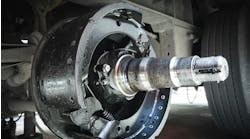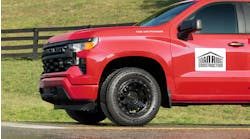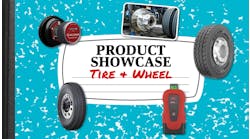Vehicle affected: 2013 VW Beetle
Issue: Uneven side-to-side brake wear on the rear of the vehicle caused by left rear brake sticking after driving
Tools used:
- Vehicle Information
- Thermal imaging camera
- Bi-directional scan tool
- Brake caliper pad push tool
- Dial indicator
- Brake pressure gauge set
- Lab scope
- 4-wheel alignment machine
Every once in a while, a vehicle will come in with an issue that seems common, but after you perform all the normal service steps it turns out the issue is far from normal. You may think that uneven brake wear and a sticking brake would be taken care of with a normal brake service and replacement of the calipers. This VW had been sent to us from a shop that had repaired or replaced all the common parts that typically cause such an issue.
In cases like this, where parts have been replaced by another shop, diagnosis may be more complicated because you do not have the original worn parts to assist you in determining what the possible cause of the issue may be. Additionally, you cannot be sure the parts that have been replaced were of high quality, or were even the correct ones. Compounding these possibilities is a chance the work itself was not performed correctly.
Step 1 - Obtain information
As always, information is the key to a successful repair. Obtain details such as when the issue occurs. This could mean the time of day, how long the vehicle has been driven, how long it has been since it was driven, how often or intermittent it happens, and when the problem first started.
Beyond repair history, having access to specifications, repair procedures, and TSBs is necessary to complete a quick and accurate diagnosis and repair. With the abundance of vehicle information available (and the great job the vehicle information providers are doing to make it available) it may be preferable to rely on more than one source to get as much data as possible.
On this vehicle we used Mitchell 1, IdentiFix and IATN to look for TSBs, specifications, and to check to see if there had been other vehicles with similar issues. There were no specific TSBs, but we did find a couple of interesting items we will point out later in this article.
Since this vehicle came from another shop, a complete history was not available to us without speaking to the vehicle owner directly, so we would need to rely on the information the other shop provided.
The other shop said the vehicle originally came in for brake service and the customer stated the rear brakes had been replaced somewhat recently and seemed to smell at times. They found the left rear brake pads excessively worn, and the rotor showed signs of overheating. Not finding any current issues, they replaced the rear calipers and rotors, checked the parking brake and bled the system.
After about 5,000 miles, the customer returned complaining the brakes still smelled. The shop checked the brakes and found the left rear brake excessively worn again. This time the shop spent a considerable amount of time researching to see if there were any TSBs or posts of similar issues on other cars. They also spent some extra time trying to duplicate the issue and found that occasionally, there was a slight dragging of the brake after it had been driven.
They determined at this time the best course of action would be to replace the calipers again, as well as the brake hose to the rear wheels. A test drive after this repair indicated no issue, so they released the car to the customer, only to have it return in a few weeks with the same problem.
Getting frustrated now, the shop started replacing other components that may cause the problem, such as the ABS module and master cylinder, all with no success. Their next step was reaching out for assistance, us.
Step 2 – Diagnose the issue
Diagnoses always begin by duplicating the concern on the vehicle. We drove the vehicle for about 20 miles, then used our thermal imaging camera to see if there was a temperature difference between the left and right brake rotors. We saw a higher temperature of about 100 degrees F on the left rear rotor, and the other three wheels within 20 degrees F of each other.
Now that we've confirmed the issue seems to only occur at the left rear wheel, we can start testing specific components.
We connected our scan tool to check for codes in any of the modules, especially the ABS system. Having none, we then checked for any irregularities in the data stream. The data stream appeared to be normal, but we thought it would be best to drive the vehicle for an extended road test while looking at the ABS data to see if anything showed up. Observing data on the road test showed no faults.
Next we decided to look at the rear brakes a little closer, and check to see if the issue was being caused by the parking brake mechanism. We removed the calipers and used our caliper pad push tool to reset the calipers and to make sure there was no binding of the calipers or the parking brake lever. We have seen hub runout issues cause ABS issues before, so we used a dial indicator to make sure there was neither excessive runout of the rotor nor play in the hub.
Not finding any signs of a problem, we remounted the calipers and connected a brake pressure gauge to the vehicle. A brake pressure gauge comes in handy when you have an issue like this, but you need to understand that it is used as a comparative tool. As is the case with most pressure tests, a brake pressure tester is used to compare readings on that specific vehicle, under the current conditions. It is extremely difficult to find a pressure specification for applied brake or residual pressure on most vehicles, but when connected from one wheel to another, or front to rear, it is easy to see if there is a pressure imbalance in the system.
When we tested this VW, we found there was a slight amount of pressure on the left rear wheel with the brakes released, and no pressure on the right rear.
Now that we know the issue is caused by pressure in the system, we can start looking at the potential causes. We were fairly certain the problem was with a fault in the ABS system, but we needed to determine the root cause.
Even though we were pretty sure there was not a problem with the wheel speed sensors, history suggested we check them with a lab scope anyway. Connecting a lab scope to both the rear sensors and rotating the wheels at the same speed should show both signals matching exactly. Our tests confirmed no problem with the sensors.
Step 3 – The repair
We decided it best to bleed the ABS system since the other shop said they had replaced the module. ABS bleed procedures are specific to the year, make and model of the vehicle; there is not a “one-size-fits-all” process.
Due to this, it is best to return to your vehicle information source for the procedure. Remember we said we found a couple of interesting items when we searched the information database? What we found was some specific information relating to the bleed procedure reliant on the steering angle sensor adjusted properly prior to bleeding the system.
Like many newer vehicles, the steering angle may cause brake pressure to be applied to an individual wheel during a traction control or ABS event in order to maintain steering control. The angle of the steering is one of the inputs into the control module that determines whether it is necessary to apply brake pressure to maintain control.
The best way to reset the steering angle sensor is to perform a four-wheel alignment on the vehicle. After the alignment is done, use your scan tool to complete a steering angle reset. According to the specific repair information on this vehicle, it is required to set the alignment and perform the reset when the steering wheel is in the center of its tilt range. The reason this needs to be done is as the steering wheel tilts up or down, the wheel angle changes slightly.
After the alignment and steering angle reset, we manually bled the brakes using the specified procedure along with our scan tool.
Another piece of information we found was, after bleeding the system the vehicle manufacturer suggests driving the vehicle safely while performing an ABS stop. You should feel the brake pedal shudder and the light come on during this process. Once this is done, re-bleed the system using the same procedure that was used to originally bleed the system. To be honest, we perform this ABS verification on every vehicle we do any brake service on.
Step 4- Verify the repair
In order to verify this repair, we will need to drive it under the same conditions that we used to cause the original problem. In this case, it involved an extensive test drive to see if there was any excess heat or drag on the brake. After the test drive, we checked each brake for consistent heat using the thermal imaging camera. This test showed even temperature at every wheel. Next, we checked to see if there was excess drag on any wheel. Each wheel spun equally, indicating no issue. Just to play it safe, we drove the vehicle again and used the brakes excessively to build a lot of heat. Additional testing found no issues with either brake drag or uneven heat.
The vehicle was returned to the other shop with the instruction to have the owner return for periodic checks over a short period of time to make sure the problem did not return. Checking with the other shop confirmed the issue did not return.
To sum it up, it is somewhat easy to get complacent with seemingly routine repairs. When problems occur, we rely on our experience with similar faults to correct issues when they occur, but there are always going to be unique circumstances that come up. Using every piece of information at your disposal, keeping an open mind, and going the extra mile will almost always resolve anything that comes up.




